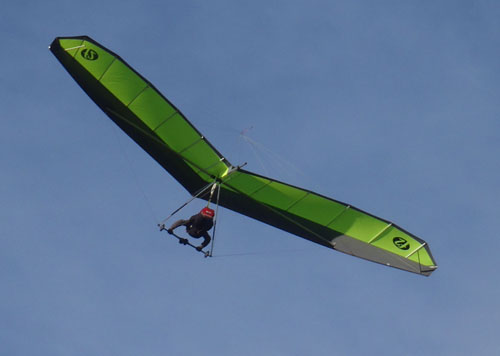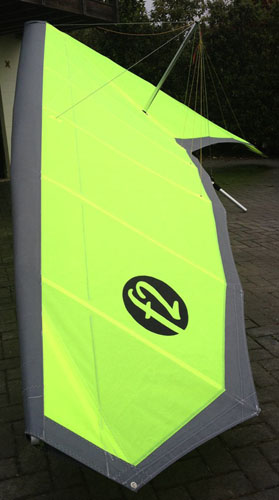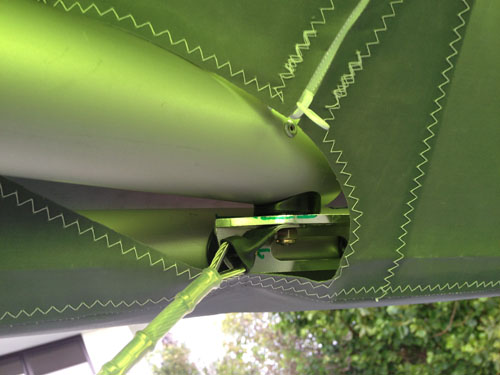Fun 190 Upgrade to Fun2; Review

NZs most popular hang glider of recent years, the Airborne Fun 190 is everywhere; as a dune glider, recreational thermal wing and the indisputable favorite for training. When Airborne updated it to the Fun2, It was hard to imagine how they could improve it.
Changes

Well improve it they did, obviously in looks with the attractive ‘rim & fill’ sail layout but the new glider has undergone a thorough overhaul in all departments without any sacrifice of the features that made it so popular.
The trailing edge layout should ensure longer sail life as the trailing edge cloth is now loaded straight along the strongest direction of the fabric, which should prevent ‘floater flutter’ for some time more than previously.
Leading edge pockets are standard, but mylar inserts are optional, the glider has much smoother leading edge panels, gone are the leading edge wrinkles of the earlier Fun and the glider’s performance benefits with better efficiency. I got the mylar inserts with my glider and couldn't detect any loss in handling.
The new cambered outer battens go in much easier, there’s no more fiddling inside the sail to locate those strut hooks.
Lufflines now attach a little forward of the trailing edge making it impossible to snag on batten ends and they can even stay connected to the kingpost when packed once you learn the sail folding method.
This glider is definitely a contender for a sub 3 minute rig up which I could never quite crack with the old model.
On the complete model, new length uprights and fittings allow optional aerofoils and even aerofoil and carbon basebars for those that want them.
In flight, it’s hard to improve on the original Fun's handling but the Fun2 feels just as good to me, however efficiency is noticeably better in turns and on glide. I took it places into wind that required a better glide and it didn’t disappoint. There’s a better glide at speed too though it's still not a fast glider. However it will worry older enclosed crossbar gliders on glide and outclimb anything else in the air as well as having far more control authority if the air gets rough. Pitch pressure is less now but still comfortable, so I’d expect it will be easier to aerotow too.
Overall it looks a lot cleaner, there’s even a nosecone to finish off the front. The improvements provide noticeable performance and convenience with no penalty to the legendary handling and landing ability.
The Retro kit Upgrade

Best of all you can buy a Fun2 kit to upgrade an old Fun 190. Unlike high performance gliders, many airframes on Funs are in near perfect order, as Funs are ridiculously easy to land and many have never been whacked in. This makes them perfect candidates for a sail upgrade.
Doing the upgrade requires removal of the sail, which is not too difficult on a Fun, and Airborne supplies detailed instructions, but still it's a job that requires an expert, the right tools, some 5 minute epoxy, a large carpeted area, and 4-6 hours. It’s a good time to fully check the old airframe.
The kit comes with the new sail, new crossbar brackets, new sidewires and lever tip batten fittings, with all the bolts, nuts and rivets required. In many cases it’s time to replace those sidewires anyway. The new wires are a different length to the old ones as they attach in a different position.
Some of the battens need serious reshaping. Many will find this quite a challenge as these are tough 7075 battens and with the force required, it's possible to break them easily! A batten former is essential to get both the right shape and to get them exactly symmetric.
When you’ve finally got the new batten shapes, and matched the curves on each side, you cut the batten ends to the new lengths and epoxy the new batten sockets in.
Sail fitting is straight forward and the sail attachments at the nose now fit on the nosebolts, however the keel pocket is riveted to the keel.
Finally the main hangpoint needs to be shifted rearward by 25mm. You can simply swap the main and backup if they are in the old standard positions. There’s a new sticker supplied so you don’t forget the new position. Also supplied is a new crossbar sticker with a new serial number to make it officially a new model glider.
There's a final checklist to go over once finished and rigged. Setting all the lever tip tensions requires a fair bit of fiddling, but once it’s done, the cleaner trailing edge will surely save some drag.
Then it's time to head out for test flying and possibly a little more batten tip tuning.
All done, I found it a very worthwhile upgrade. If you have a Fun 190 with a good airframe and a worn sail, it’s effectively a new glider at half price with noticeable performance and convenience benefits that you'll appreciate.
Copyright: B. Degen 2012
UPDATE; Floater performance
The Mt Cheeseman Meet was supposed to be a 'League', then I was told just a 'fun' fly meet, I thought what better to fly there than the new Fun2 and to try out a new instrument. When we got to launch, there was only one other kingpost to be seen and all were kitted out in their comp gear with topless gliders. Several were fresh from competing in Oz comps.
Fortunately for the topless gliders the thermals were large but unfortunately not going very high above the top of the mountains. Being a bit late, as soon as I got to the top of the stack, I was off - with an Atos chasing me. It was scratchy on the ridges but I was able to turn tight and stay up. Landings would have been tricky for other gliders where I went, but of course no trouble for a Fun. At the first turnpoint there were no other gliders to be seen so I figured they'd all made it back (upwind) to turnpoint 2 and to goal.
I made sure I had good height before leaving and the Atos cruised past me on the way to the second turnpoint. I worked every little bubble of lift; many times thermalling back, then pushing forward into wind. After a low save from under 500ft in a light but scrappy thermal, I eventually made the second turnpoint too low to find any more lift. It turned out that only one (topless) glider had made the same distance and the rest had landed 5 or so kms behind me.
Handling, sink rate and patience had won the day. This experience just goes to show that often it's not the fastest glider but the one who can stay in the air that does best.